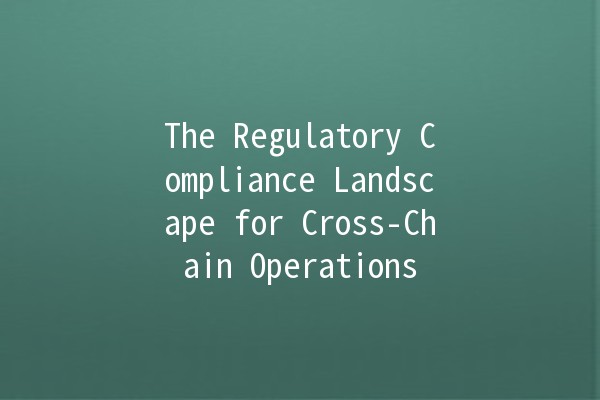
In the rapidly evolving world of blockchain technology, crosschain operations have emerged as a vital component for creating interoperable ecosystems. These operations enable different blockchain networks to communicate and interact seamlessly, thereby enhancing the functionality and scalability of decentralized applications (dApps). However, as the landscape expands, so do the regulatory challenges and compliance requirements that come into play. This article delves into the current state of regulatory compliance for crosschain operations, providing practical insights and tips for navigating this complex environment.
Understanding CrossChain Operations
Crosschain operations refer to the mechanisms that allow transactions or data exchanges between different blockchain networks. The primary aim is to enhance usability and access to resources while maintaining security and decentralization. The increasing demand for interoperability has led to the creation of various protocols and solutions, such as blockchain bridges and atomic swaps.
For instance, a user looking to transfer tokens from Ethereum to Binance Smart Chain can use a bridge that ensures secure asset exchange between the two platforms. However, the unique characteristics of each blockchain can introduce specific regulatory considerations.

Regulatory Challenges for CrossChain Operations
One of the primary challenges in regulatory compliance is understanding jurisdictional boundaries. Different countries have varying regulations regarding cryptocurrencies and blockchain technology. Therefore, crosschain operations can complicate compliance, as the transaction might involve participants or assets from multiple jurisdictions.
Tip: Stay Informed on Regional Regulations
Organizations engaged in crosschain operations should invest time in researching the regulatory landscape of each jurisdiction where they operate. This can include understanding antimoney laundering (AML) requirements, know your customer (KYC) regulations, and tax implications.
The classification of digital assets is another significant hurdle. Regulators often categorize cryptocurrencies based on their functionalities—such as utility tokens, security tokens, or stablecoins. This classification can directly impact compliance requirements, particularly regarding securities law.
Tip: Conduct Thorough Asset Analysis
Before initiating crosschain transactions, conduct a detailed analysis of the assets involved. Consider consulting legal experts wellversed in digital asset regulations to determine the appropriate classification and compliance obligations.
Smart contracts are selfexecuting contracts with the terms directly written into code. While they enhance efficiency, they also pose unique regulatory challenges. Compliance with applicable laws requires transparency and accountability—qualities that can sometimes be obscured by the complexity of smart contracts.
Tip: Implement Auditing Mechanisms
Incorporate auditing mechanisms during the smart contract development phase. Regular audits can ensure compliance and help identify potential legal issues before deployment.
Crosschain operations often involve the exchange of user data, raising concerns about data privacy and protection. Regulations such as the General Data Protection Regulation (GDPR) in Europe impose strict rules on how personal data is collected, stored, and shared.
Tip: Prioritize Data Protection Strategies
Implement robust data protection strategies across all blockchain networks involved in the crosschain operation. This may include encryption, regular data audits, and thorough data handling procedures to comply with applicable privacy laws.
Ensuring compliance across diverse blockchain networks can be challenging due to different underlying technologies and governance structures. Organizations must develop comprehensive compliance protocols that can adapt to the specific requirements of each network.
Tip: Develop a Unified Compliance Framework
Create a unified compliance framework that outlines how your organization will comply with applicable laws across all chains involved. This framework should include standardized procedures for KYC, AML, and reporting, which can streamline operations and reduce the risk of noncompliance.
Practical Strategies for Enhancing Compliance in CrossChain Operations
Utilize compliance technologies (RegTech) designed for the crypto and blockchain space. These technologies can streamline the compliance process by automating KYC checks, transaction monitoring, and reporting.
Example: Tools like Chainalysis and Elliptic can provide robust analytics capabilities to detect suspicious activities and ensure compliance with regulatory standards.
Consulting legal experts who specialize in blockchain technology and regulatory compliance can provide valuable insights. They can guide you through the intricate web of regulations affecting crosschain transactions.
Example: Hire a legal consultant with experience in navigating international regulations, particularly those in the countries where you have significant user bases.
Fostering a culture of compliance within your organization is vital. Create clear communication channels through which employees can discuss concerns related to compliance and report potential violations.
Example: Consider implementing an anonymous reporting system that enables employees to voice compliance concerns without fear of retribution.
Regular compliance training sessions empower employees with the knowledge necessary to navigate the complex regulatory landscape. Training should cover relevant regulations, internal compliance protocols, and potential risks associated with crosschain operations.
Example: Organize workshops led by compliance professionals to ensure your team remains abreast of the latest regulatory developments.
Given the dynamic nature of blockchain and cryptocurrency regulations, staying updated on regulatory developments is critical. Engage in regular reviews of legal and regulatory changes that may affect crosschain operations.
Example: Subscribe to newsletters, attend blockchain conferences, and participate in forums to remain informed about emerging regulatory trends.
Frequently Asked Questions
Regulatory challenges include jurisdictional issues, the classification of digital assets, smart contract compliance, data privacy concerns, and the need for comprehensive compliance protocols across multiple networks.
Organizations should research regulations specific to each jurisdiction they operate within. Consulting with legal experts and implementing regionspecific compliance measures is crucial for navigating jurisdictional complexities.
Noncompliance with regulations governing smart contracts can result in legal penalties, financial losses, and damage to reputation. Regular audits and adherence to legal standards are essential to mitigate these risks.
Data privacy regulations impose strict rules on how organizations handle and protect user data. Crosschain operations must prioritize data protection strategies to ensure compliance with regulations like GDPR.
Implementing compliance technologies, engaging legal experts, establishing clear communication channels, conducting training, and monitoring regulatory developments can all enhance compliance in crosschain projects.
Stay informed by subscribing to relevant newsletters, attending industry conferences, joining blockchainfocused forums, and engaging with legal professionals who specialize in digital asset regulations.
By proactively addressing these regulatory challenges and implementing robust compliance strategies, organizations can successfully navigate the complexities of crosschain operations, ensuring both legal adherence and the promotion of a secure and interoperable blockchain ecosystem.

